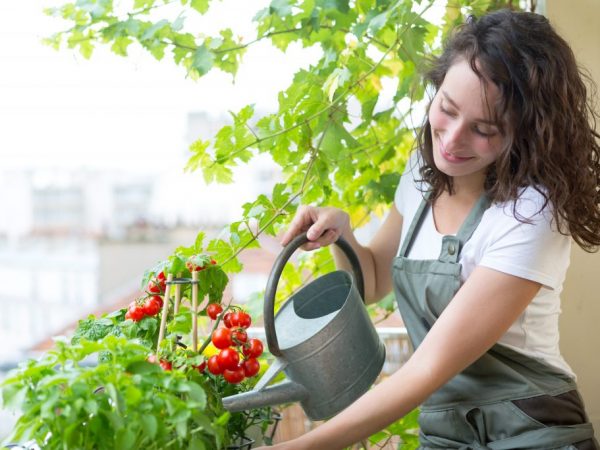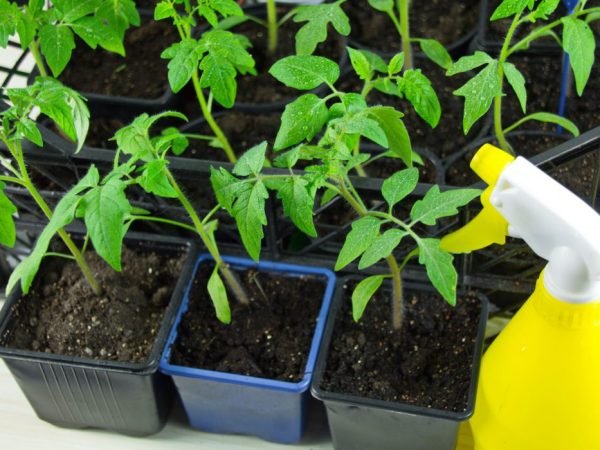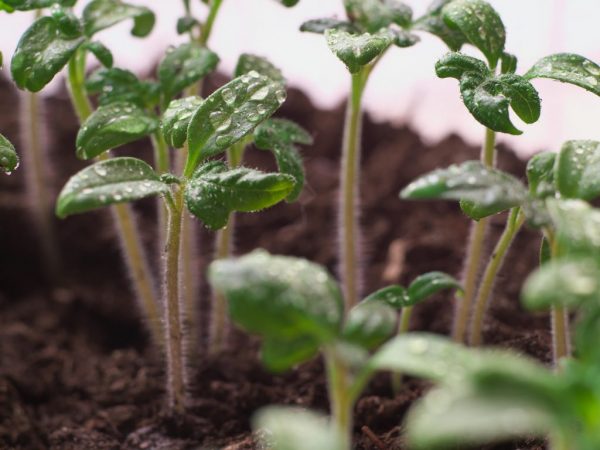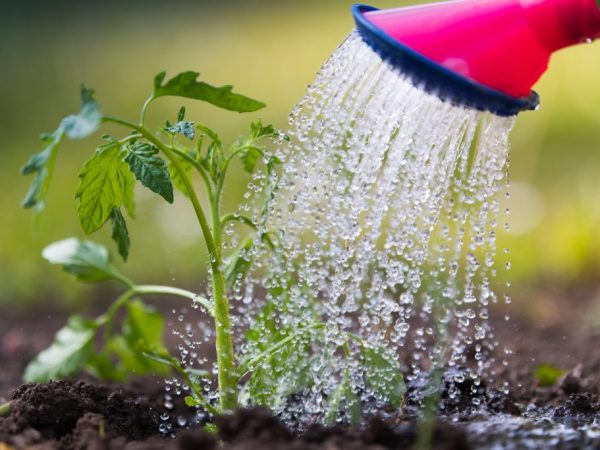Top dressing of homemade tomato seedlings
To grow tomato seedlings at home on your own, you will have to pay a lot of attention to the vegetable culture. Feeding tomato seedlings helps to grow strong and healthy plants. Together with proper watering, good lighting and warm air, fertilization with nutrients for tomato seedlings is the key to a good harvest.

Top dressing of homemade tomato seedlings
When you need top dressing
Choosing what to feed home tomato seedlings is required when the soil for growing a vegetable does not have all the necessary fertile qualities and is not nutritious enough. By the external signs of tomato seedlings, one can judge the need for feeding:
- watering with unsteady water, in which there is too much chlorine, leads to lightening of the leaves of seedlings, when veins are clearly visible on them, in cases with a lack of an iron-containing component, tomato tops also begin to fade, showing signs of chlorosis,
- lack of nutrients is expressed in rolled leaves,
- lack of magnesium is expressed in the form of fragility of the stems, which break even with a light touch,
- with a lack of phosphorus-containing elements, tomato tops become dark and repainted in purple shades, more often from the lower side of the leaf blade,
- with a small amount of nitrogen, the seedlings stop growing or develop too slowly, the foliage begins to turn yellow and wither.
Top dressing of tomato seedlings is not needed when summer residents are careful about choosing a substrate. In many cases, the nutrient soil mixture becomes sufficient for full-fledged cultivation of tomatoes without top dressing before planting in open ground.
General recommendations
Most summer residents prefer a two-time schedule for feeding tomato seedlings. The initial feeding of the plants begins 2 weeks after the diving procedure. Summer residents repeat secondary feeding of tomatoes after a similar period of time - 14 days.
Do not count on the fact that the more you feed the tomato seedlings and increase the amount of top dressing, the faster it will immediately become healthy and strong. The uncontrolled use of mineral compositions leads to diseases of the vegetable crop and causes the development of too powerful tops.
With the poverty of the soil, top dressing of tomato seedlings at home is carried out immediately when the first leaf appears on the seedling. Such early feeding of tomato seedlings allows young sprouts to resist fungal infections, among which late blight is the most common. subsequent feeding is repeated after 10-14 days.
Basic Rules

The rules should be followed
When carrying out the bait procedure, a number of rules must be observed:
- before feeding, the sprouts are watered without fail,
- exceeding the recommended norms of nutrient compositions has a detrimental effect on the plant, therefore, the dosage of the drugs used and the amount of organic matter used are not exceeded,
- with sufficient indicators of the nutritional value of the soil, they refuse bait altogether,
- in the process of applying nutrition, the reaction of tomato seedlings to the mineral compositions used is monitored in order to stop them in time in case of excess or increase the dosage in case of a shortage.
Basic formulations for home feeding
For feeding tomato seedlings when growing at home, popular formulations are most often used.
Copper
When grown at home, tomato seedlings are fed with a copper solution. It is made from copper powder in a ratio of 1 small spoon to 10 liters of water. Copper feeding allows young seedlings to develop fully and protects them from damage by late blight.
Ready complexes
Along with the use of copper in the process of initial feeding of tomato seedlings, it is possible to fertilize the soil with a ready-made complex composition Phytosoporin, which has bioenergetic properties.
To saturate the soil for growing tomatoes with a nitrogen-containing component, potassium and phosphorus, the complex fertilizing composition of nitrophoska allows: 1 tbsp. l. the drug is diluted in a 10-liter bucket of water. Tomato sprouts are not watered with nitrophosphate too abundantly. Instead of this drug, you can use nitroammophos and azofos, which combine well with sodium humate.
The germination of seeds will be accelerated by treatment with Epin and the introduction of micronutrient fertilizer Baikal.
In the second fertilizing procedure, the ready-made Agricola complex is most often used. It is also used regularly at intervals of every 10 days after picking seedlings, when the plants experience a stressful state after getting used to a new place.
Urea

Nitrogen will ensure good seedling growth
The full development of tomato seedlings is impossible without the presence of nitrogen in the soil, the source of which is feeding with urea. 1 tbsp. l. the drug is dissolved in 10 l of water. Watering young seedlings with urea can be quite abundant. The first procedure is carried out before planting tomato bushes, the second - at the adaptation stage 2 weeks after the pick.
Superphosphate
Foliar feeding of young tomato sprouts is as important as the root one. For foliar feeding, many prefer spraying with superphosphate. 1 tbsp. l. the preparation is diluted in a liter volume of water and heated to an average temperature of 80 ° C. Subsequently, the resulting composition is defended throughout the day, the light part is drained, its volume is brought to 10 liters. Tomato seedlings are sprayed with working fluid by means of a spray bottle.
Organic fertilizing
Summer residents, when choosing what to feed tomato seedlings, prefer to use organic matter when growing tomatoes at home.
Ash
Tomatoes, which absorb potassium and phosphorus well, respond favorably to the fertilization of soil with wood ash, which can destroy all fungal infections.
When using wood ash, fertilizer complexes containing nitrogen cannot be used at the same time. Nitrogen-containing compositions are introduced only a month after the ash feeding.
You can prepare fertilizer with ash from 1 tbsp. l. wood organic matter mixed with 5 liters of heated water, infusing it for 1 day. Ash fertilizer is applied under the seedlings.
Compost
To feed tomato seedlings grown at home, some people use compost, pouring it into boxes with seedlings. Compost can be used diluted.
Biohumus
Microbiological organic matter biohumus allows you to improve the fertility of the soil, most often it is recommended to feed them the soil before planting a vegetable crop. It can be entered all year round. Some summer residents use biohumus already at the stage of seed germination, soaking them in a solution with organic matter for half a day.
Mullein

Mullein will help plants to root
Mullein fertilization helps plants adapt after planting in open ground, when they begin to take root and actively grow. An infusion with mullein is made in a proportion of 1 share of mullein per 10-liter volume of water, adding a large spoonful of nitrophosphate. The watering rate for each tomato bush is 0.5 liters of working fluid.
Medicines
You can fertilize seedlings so that the stems grow thick and strong, you can use various medications.
Iodine
Fertilizing tomato seedlings with iodine allows you to grow strong sprouts, laying the foundation for future healthy ovaries and high yields. In some cases, summer residents use ready-made water-soluble iodine-containing fertilizers, but sometimes they prepare such working liquids for bait on their own. For foliar feeding of tomato seedlings, it is enough to dilute 2-3 drops of simple medical iodine in 4 liters of water and spray tomato sprouts with this composition. At the stage of growing seedlings, just one bait with iodine will be enough.
Manganese
Potassium permanganate feeds tomatoes with manganese, taking an active part in photosynthesis and increasing yields. For this purpose, spraying is carried out 1-2 times every 14 days with a solution made in the proportion of 2 g of potassium permanganate per 10-liter volume of liquid.
Hydrogen peroxide
Tomato seedlings are often sprayed with hydrogen peroxide for prophylactic purposes, for which 15 ml is mixed in water (10 l), sometimes adding 30 drops of medical iodine. For irrigation with hydrogen peroxide, the concentration is increased by diluting 4 large spoons of the medicine in 3 liters of water.
Ammonia
Feeding the seedlings with ammonia helps to cope with nitrogen deficiency and stimulates growth so that the seedlings are stretched and strong, with a thick stem. A weakly concentrated solution is obtained from the proportions of 1 tbsp. l. for a 10-liter volume of water, which is enough for a single first watering of the sprouts after picking.
Food products
Some food products can be a source of elements useful for tomatoes, therefore gardeners love to use folk remedies.
Yeast
Yeast fertilizer is popular among summer residents who grow tomato seedlings at home. The fungus contained in yeast makes it possible to activate the vital activity of microorganisms present in the soil. Dry and raw yeast are rich in mineral elements necessary for the immunity of tomato seedlings at the germination stage, especially for the root system.
Instead of yeast, some summer residents have adapted to use bread and crackers to fertilize seedlings.
For yeast fertilization, 100 g of any yeast is dissolved in warm water and 2-3 tsp are added to the fermentation process. granulated sugar. The working liquid is insisted during the entire fermentation process, and then the yeast starter is diluted with 5 liters of water and the seedlings are watered 7 days after planting in open ground. The next watering of the yeast culture is carried out after the rooting of tomato bushes.
Shell
Making fertilizer from the shell is quite simple: you need to insist for 4-6 days crushed shells of 3-4 eggs, diluted in 1 liter of water. The solution is used for irrigation.
Onion husks
Onion husks include many antibacterial components, therefore it helps to feed seedlings and at the same time fights pests. For a 10-liter volume of water, 50 g of onion husks, aged for 5 days, are enough. Seedlings can be fertilized both by spraying and watering.
Milk
Plain milk, which contains a large amount of potassium, is valuable for plants during the growth stage. To feed the seedlings, 1 liter of milk is diluted with 5 liters of water and the sprouts are watered.


